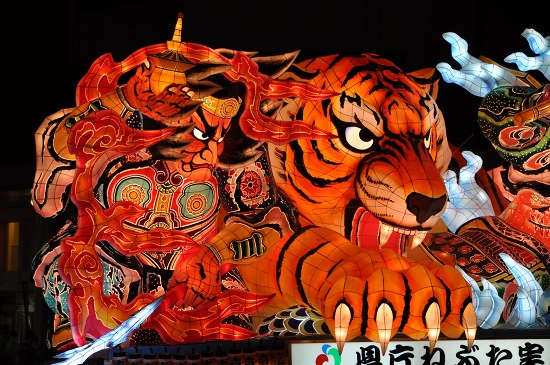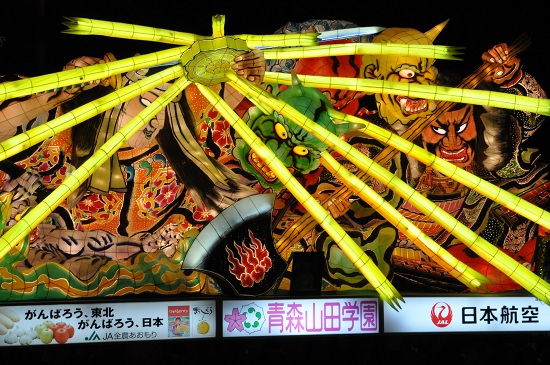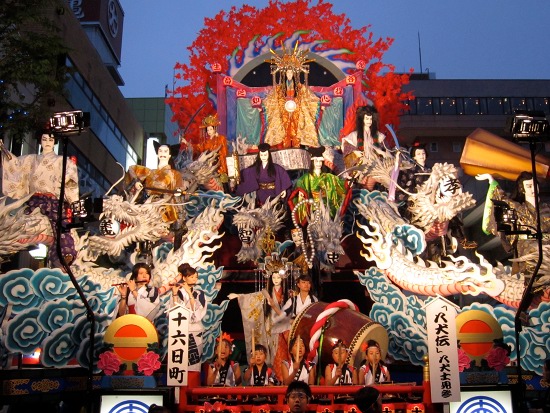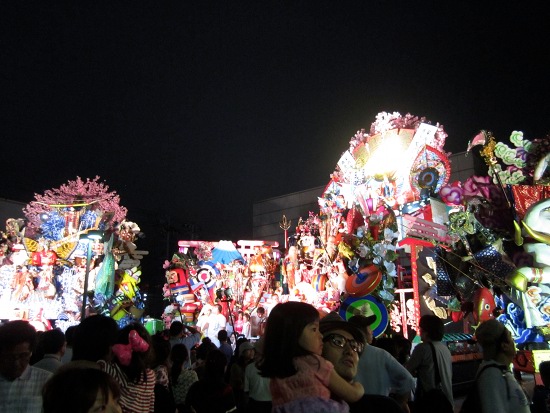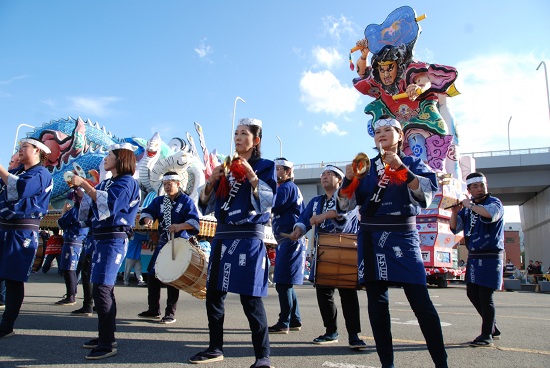Summer festivals are all about demons and heroes. Hachinohei, Aomori. Photo courtesy Mike Nakada.
Summer is the season Japanese go all out to celebrate their culture. Festivals are bigger, brighter and louder. Ghosts and demons come out to play too, dancing to the beat of drum and flute. Is it hot? Oh, yes. And sweaty. But there's cold draft beer or sweet shave ice to help you cool down, and the sights, sounds and colors of a Japanese summer are worth the heat.
Northern Japan especially pulls out all the stops in the first week of August. It's one big party. Don't let the distance from Tokyo put you off. Smart travelers can use their Japan Rail Pass (check out the details here) to speed from Tokyo to Aomori in around three hours. The real problem is picking which festival you want to attend.
Giant Nebuta floats light up the night as they parade through the city. Photo courtesy Mike Nakada.
Nebuta Matsuri, Aomori City.
Any Japanese will tell you, this is Japan's number one festival. Come. You will not be disappointed.
Around two dozen massive, themed, lantern floats of demons, gods and ancient heroes light up the night. They dip and spin as the crowd cheers them on, daring them to come closer. A legion of drummers and musicians march with each float and between them, masses of dancers in traditional costumes covered with jingling bells and madly decorated hats gyrate wildly while shouting the traditional chant of "rasera rasera." This is uninhibited Japan on a scale you have never seen before.
The rhythmic music and chanting of the dancers is jubilant and uplifting. That's because the festival celebrates a victory in an ancient battle when everyone was very glad to be alive!
Floats can be as long as nine meters. Each is pulled by teams of men and women huddled underneath. Photo courtesy Mike Nakada
Although you can buy seats in the stands along the route for 2,500 yen ($25), it is easy to find standing room since the parade stretches for three kilometers, winding in and out of the downtown area.
Be sure to allow time to walk down to the ASPM building on the waterfront where all the floats are on display from the middle of the afternoon. (You can't miss this landmark triangle building.) The floats can be as tall as nine meters and up to five meters wide with a different theme every year. Check out every float up close and pick your favorite to watch for that night. There's entertainment, food, and drink and a lot of camaraderie among the festival goers and participants.
Visitors can join in the dancing -- you'll actually see quite a few foreign dancers from the nearby military base -- but must have the correct costume. These can be rented at stalls along the shopping street. They run from $30-$50 per set.
Dates: August 2-7, but time your visit for the 4th, 5th or 6th when the full array of floats parade each night between 7 p.m. and 9 p.m. The 7th, is an afternoon procession, with a large fireworks display over the bay at night.
Access: Shinkansen from Tokyo. The festival route is just a short walk from Aomori Station along the main shopping streets. If you get lost, ask for 'Amenity Street'. Really.
Giant motorized floats in Hachinohei tower up to three stories high. Photo courtesy Mike Nakada.
Sanja Matsuri, Hachinohei:
The Sanja Matsuri in coastal Hachinohei just a short train ride south of Aomori, is not as well known by foreigners as the Nebuta. Believe me, this jaw-dropping festival of animated floats that stretch up to three stories tall accompanied by mounted Samurai warriors, temple maidens in palanquins, Shinto priests, costumed Tengu gods on stilts, and tiger-suited acrobatic dancers is not-to-be-missed fun.
Each giant motorized float features a myth or historical event as its theme. Especially any that involve demons, ghosts, dragons, tigers, gods and goddesses. Even life-size war horses with samurai in full armor burst out from the displays. There is so much color, figures and movement, it's hard to know where to look.
As busy and colorful as they are at first sight, each float is far more than what it seems. At intervals along the parade route, motors kick in, lights flash, smoke shoots out and the float rises up higher and higher still to unfold a host of new scenes that has the crowd gasping.
Every float also has its own costumed corps of drummers, singers, dancers cheered on by the audience lining the streets.
Depending on the day, the parade is presented in the afternoon or evening. Each gives you very different viewing experiences.
Daytime is still pretty impressive and this float hasn't even started its high rise theatrics.
Daytime: The parade includes a procession from each of the three Shinto Shrines represented, interspersed between the floats. Priests, temple maidens, mounted Samurai guards, foot soldiers, and a solemn lion dog procession march by. Tora Mai, dancers dressed as tigers, provide lots of comic relief and acrobatic fun. The floats stop to display their high-rise bag of tricks, but it lacks the light-up drama of the night time displays.
In the evening everyone gathers in Hachinohei to pick out their favorite floats.
Night: The floats roll through town, then come to a stop along the street and in the wide grounds of the local government offices so everyone can walk around and spend as much time as they want to see each and every float. Music is non-stop and the floats go through their amazing theatrics every few minutes.
Another perk for Hachinohei, it's hard to find better festival food anywhere. The local fried chicken is mouthwateringly good, but there's also Indian curry, Italian pasta, Japanese sweets, BBQ corn (which Japanese consider a traditional festival food BTW), and lots more.
Dates: July 31-August 4 . Daytime parade: Aug. 1 and 3. Night: July 31, Aug. 2 and Aug. 4.
Access: Shinkansen from Tokyo to Hachinohei Station.
Kanto Matsuri, Akita:
Rural Akita prefecture doesn't get a lot of attention most of the year. It's famous for the Nama Hage winter demons and large Akita dogs, but little else. Except during August when visitors come for the Kanto lantern festival.
The festival honors the summer grain harvest and festivities center around a long procession of eight meter-tall bamboo poles decorated with 46 paper lanterns in the shape of bales of rice. Weighing up to 60 kilograms, the poles sway and dance in the night sky as skilled performers balance them on the forehead, hip or shoulder. Each group of performers is accompanied by traditional music and dance and the line of glowing lanterns stretching block after block is breathtaking.
This website has a good guide.
Word up: Akita people do not seem particularly interested in eating at their festivals....
Dates: Aug. 2-6.
Access: Shinkansen from Tokyo to Akita Station transiting in Morioka. Twenty minute walk from Akita Station.
Hirosaki builds their towering Neputa lantern floats up, not out .
Neputa Matsuri, Hirosaki
With its brightly lit paper mache floats and corps of drummers, this historical castle town's biggest festival has a lot of similarities to the Nebuta a short distance to the north. However, while Aomori builds out, Hirosaki builds its floats up.
The festival in Hirosaki was originally held to drum up fighting spirit before a major battle. As such, the music is more solemn and the procession lacks the joyous "Hurrah, we didn't die!" manic energy and fun of Nebuta.
2013 Aug. 2-7, evening procession of floats Aug. 2-6 only.
Morioka Sansa Odori Festival:
The north is rich in demon lore and the stories are still very much a part of local life. Morioka's Sansa Odori is a procession of drummers and dancers in colorful traditional costumes celebrating the banishment of a giant demon that tormented the region in ancient times. The city is the capitol of Iwate prefecture. The word "Iwate" means stone hand and stands for the imprint of the demon's hand on a huge boulder, signifying his agreement to never return.
Although it lacks the scale of the others, the sight of ten thousand costumed Taiko drummers in colorful cotton kimonos, dancing and chanting is still pretty cool. If you want to join in, wait until the procession ends at the Waodori circle dance.
The Iwate Tourism website has great pictures.
Dates: August 1-4.
Access: Shinkansen from Tokyo to Morioka Station. Dancing is held on the other side of the river, starting from the City Office, about a 15-minute walk from the station.
Summer festivals mean colorful cotton Yukata kimonos.
Travel tips:
It is possible to do both the Nebuta and Sanja Matsuri in Hachinohei and several other events as well on the same visit. This year I'll head for Hirosaki on Aug. 3, Hachinohei on the. 4th and Aomori on the 6th.
Since hotel rooms are very costly in Aomori during Nebuta, I make reservations outside the city. I've found Morioka makes a good base as it has a number of low-cost business hotels clustered around the main station. As long as you have a Japan Rail Pass, it's possible to zip back and forth between the cities. Just note, the last Shinkansen out of Aomori to Morioka is 9:46 p.m., so plan your celebrations accordingly.
No matter where you are in Japan during mid August, you should be able to find a Bon Odori festival. O-Bon celebrates the season when the souls of the dead can return to visit the living. One reason Japanese think of summer as the scariest time of year.
Festivals are anything but morbid. Instead, they are packed with food, drink, traditional music and dancing. Dates vary but these festivals are held in every city and town throughout country. If you're in Tokyo, Roppongi Hills is holding their big Bon festival on Aug. 23-25. The stage and dancing is set up in the plaza on the lower level in front of the TV station.
There are many more late summer festivals big and small.
Feel free to email me with any questions!

